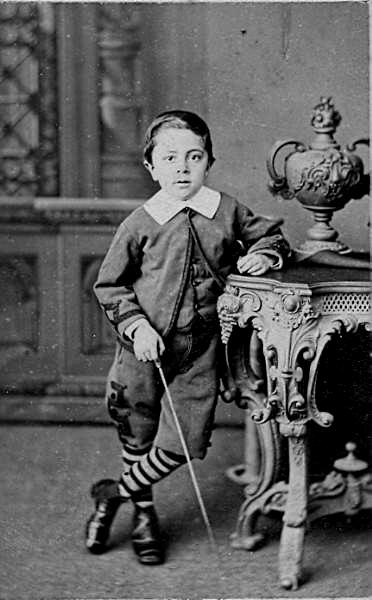
Uruguyan Boys' Garments

Figure 1.--Here a CDV portrait shows an unidentified Uruguayan boy wearing a cut-away jacket and Eton collar with a vest and wide-leg knee pants. Note the enrroidery. The stripped long stockings were popular. The portrait is undated, but looks like the 1870s. The studio is Chute & Brooks in Montevideo.
|
|
As far as we can determine there are few destinctive Uruguayan styles for boys' clothing. We see boys, especially boys from affluent families, wearing the same clothing fashions worn in Europe at the time. Of course these are the families that can aford photographic portraits. Our Uruguayan archive is very limited so we have not yet been able to assess Uruguayam garments in any detail. And the few images we have archived so far show boys from well-to-do families living in Montevideo or other cities, especially in the 19th century. We note garments like cut-away jackets and sailor suits that we would have identified as European had we not known the portrairs were taken in Uruguay. This is in part due to the European immigrants. Uruguau like America mnu European immigrants in the lte-9th nd early-20th century. We wouuld not be able to differentiate them from similar boys in Europe. We do not yet have any idea about the kinds of garments worn by working class boys or the boys in rural areas.
Headwear
Skirted Garments
Whites smocks were introduced for schoolwear. Both boys anf girls worecthem with blue bows.
Shirts and Blouses
We notice wide white collars in the 1870s. The boy here wears an Eton-style collar (figure 1). It is not a true Eton collar as it falls down on the sgoulders rather than standing up stiffly. This is larger than the collars we see in America during the 1870s. Perhaps it is a European fashion influence, but we do not see large white collars in America until the 1880s.
Pants
We notice both knee pants and bloomer kniockers in the second half of the 19th century.
Boys commonly wore suits in the 19th century. We have not informtion on the early-19th century. We suspect thst boys wore skeleton suits, the populsr style in Europe. Boys in the second half of the 19th century wore the many suit styles popular in Europe. Younger boys once breeched wore cut-away jacket suits with knee pants and bloomer knickers. The unidentified Montivedeo boy here in the 1870s is a good example (figure 1). He wears a cut-away jacket and vest. Notice the fancy embroidery work. We also note other suit styles like collar buttoning jackets and lapel jackets.
We have no information on the hosiery worn By Uruguayan children in the early 19th century. Wecsuspect yhat many children went barefoot. Boys from famolies in compfortable circumsance probanly wore lomg pnts skeleton suits. Girls wore empire dresses. As in Europe, the children probably wore short white socks. Uruguayan children wore long stockings as shortened-length pants becaome popular in the mid-19th century. Our archive is very limited, but we see striped long stockings in the 1870s. Bith boys and girls wore the sanme style of long stockings. long stockings.
Footwear
We note high-top and low cut shoes in the 19th century for both boys and gurls.
HBC

Navigate the Boys' Historical Clothing Web Site:
[Return to the Main Uruguayan page]
[Return to the Main Latin American page]
[Introduction]
[Activities]
[Biographies]
[Chronology]
[Cloth and textiles]
[Clothing styles]
[Countries]
[Topics]
[Bibliographies]
[Contributions]
[FAQs]
[Glossaries]
[Images]
[Links]
[Registration]
[Tools]
[Boys' Clothing Home]
Created: 7:51 AM 7/20/2012
Last updated: 4:35 AM 1/11/2019



